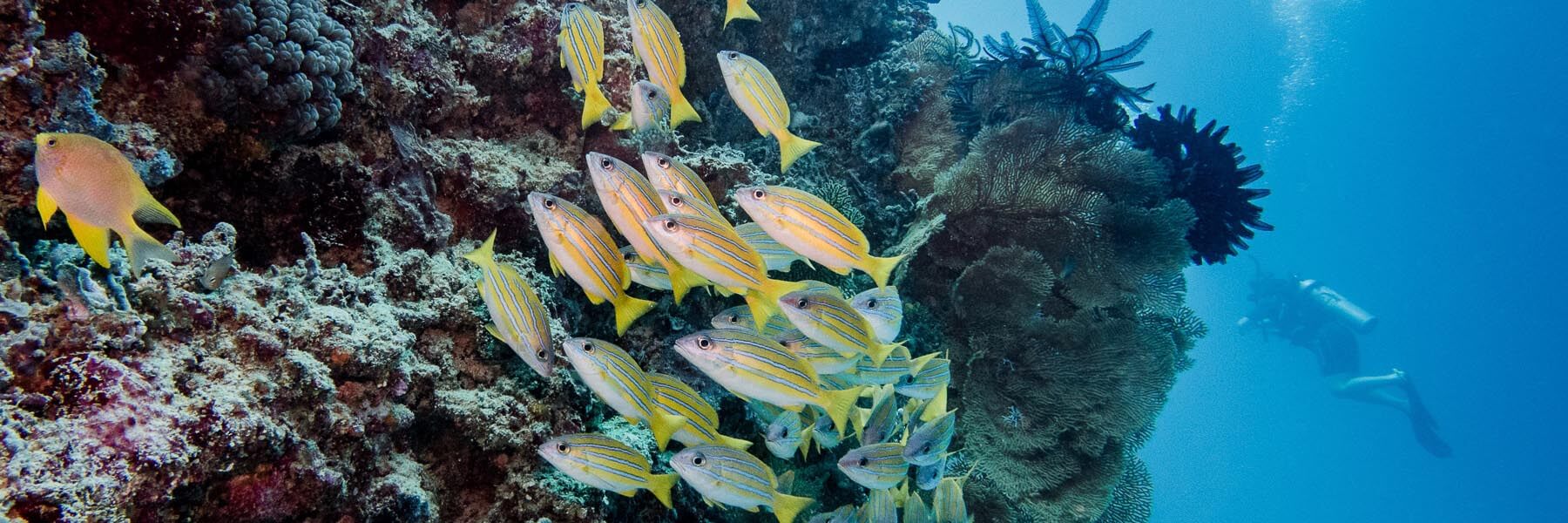Raja Ampat is located in eastern Indonesia, in the West Papua province. It takes its name from “four kings”- the four islands of Batanta, Misool, Salawati, and Waigeo. This remote archipelago is considered by many scientists as the richest place for marine life on Earth. The archipelago is a part of Bird’s Head Seascape and contains Cenderwasih Bay, the largest marine national park in Indonesia. With over 1300 species of coral reef fish, 600 species of hard coral, and 57 species of mantis shrimp, there’s no other place in the world with so much biodiversity.

Aerial View of Raja Ampat
With a large number of diving sites in Raja Ampat, you’ll be spoiled for choice. Some of the best ones are discussed below:
Mioskon
This site, with its 25 meters deep coral column is perfect for beginners and intermediate level divers. The currents are usually light but can be strong on some occasions. There is a diverse range of species, like garden eels, black snappers, barracudas, white tip sharks, and butterflyfish. Other strange creatures that can be spotted here are pigmy seahorses, sponge crabs, harlequin shrimps, and walking sharks.
Blue Magic
This is one of the most famous of the Raja Ampat Dive, and it often follows Mioskon as the second dive. The currents here are more advanced compared to Mioskon, and the depth ranges from 7 metres to 30 metres. This site provides liveaboard diving opportunities. This is one of the prime locations to view schooling fish which tend to gather when the current is running. You can also spot species like Giant Trevally, Spanish Mackerel, Dogtooth Tuna, Barracuda, Bumphead Parrots, Rainbow Runners, and if you’re lucky, even Mantas.

Sardine Reef
An offshore reef that is always teeming with fish like jacks, surgeonfish, fusiliers, batfish, and trevally, this large underwater pinnacle is oval and 200 metres long. You can also spot the less common species like Bumphead Parrotfish, Oceanic Triggerfish, and Napolean Wrasse. The depth is anywhere between 5 to 30 metres, and the currents are strong. 32 liveaboards offer dives on this beautiful reef.
Boo Island/ Boo Window
Taking its name from the two swim-holes in the rock, this is one of Raja Ampat’s most photographed and iconic diving sites. The two large rocks shelter a wide variety of flora and fauna. The reef has a gentle slope of 5 to 10 metres, after which it drops suddenly to 35 metres. The current strength is medium here and the Boo islet is small enough to be covered in a single dive. Soft corals and barrel sponges lend a beautiful colour to the sea, and you can catch unicornfish, surgeonfish, blue dash fusiliers, and even octopuses in this beautiful part of the ocean. There are multiple liveaboards as well as dive boats to take you to this location.

Photography in Raja Ampat
Cape Kri
Holding the world record for the site with the largest number of fish species (374) referenced in a single dive, this stunning reef holds vibrant soft and hard corals that make your experience amazing. From schools of small fish to black and white tip sharks, this site has it all. With a depth of 5 to 25 metres and mild to strong currents, this diving site is suitable for divers with intermediate to advanced experience. Some of the commonly found species are Grey Reef, Blacktip reef, Dogtooth Tuna, Damsels, and Anthias. You can get a liveaboard easily from any of the nearby resorts.

Melissa’s Garden
Located between the jet Fam islands and the island of Batanta, this oval reef has beautiful coral gardens with vivid colours. These hard-coral formations are full of sponges, crinoids, and coral outcrops. You can spot diverse marine life, like maroon clownfish, manta rays, great barracudas, and the strange wobbegong. Divers looking for some action can visit the ridges that are surrounded by thousands of fusiliers. With an average depth of 10 metres and mild currents, this dive site is suitable for beginners. This place is reachable from Raja Ampat via boat and there are plenty of liveaboard options.

The Passage
This is one of the most iconic diving sites in Raja Ampat, with unique ecology that doesn’t exist elsewhere. The shallow channel separates the islands of Waigeo and Gam and is just 20 metres wide at its narrowest point. The mangrove roots give you the feeling of diving through a jungle river. The nutrient-rich waters support rich marine life like bumphead parrotfish and nudibranchs. The limestone cliffs and colourful coral make this place immensely beautiful. The area experiences strong currents, so it is suitable only for experienced divers.
Raja Ampat is one of the best diving sites in the world, the regulars swear by the diversity of its marine life. Check out this customised diving trip to Raja Ampat and Sulawesi here.
If you loved reading this story, then subscribe to our blog here (it will ask to verify your email) to get inspiring travel stories and trivia delivered to your email. Stories about wildlife trivia, cultural experiences, curated luxury hotel lists, underrated places to travel, polar journeys and much more.











